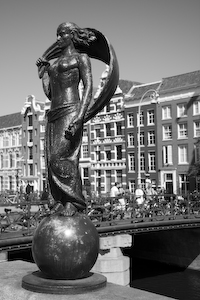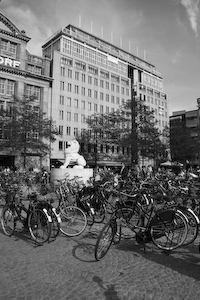


There are a number of rules that you can follow when you compose the image that your are creating. When to break these rules comes which experience as these rules are only guidelines. Therefore it is up you as the photographer to decide when or if to break or bend the rules. Once you have mastered these rules you will be in a better position to judge whether you should follow them or bend them.
The goal of photographic composition is to arrange the key elements and details of the image in such a way so that the final image is balanced and interesting to the viewer. Whether a composition is successful is subjective as it is the viewer who determines whether a composition is good or not.
In Photography a popular rule is the Rule Of Thirds which is and has been used by non photographic artists. In its simplest terms you divide your image into thirds both horizontally and vertically. You then place the important elements of your composition in the intersection of these areas.
The Rule of thirds helps you produce a balance picture that can be pleasing to the eyes. By placing your subject to the left or right (top or bottom) centre you create interest, Images that have the subject in centre tend to be uninteresting and dull.
Always consider your view point, from which you take the image. It is not always possible for your subject to move, so you may have to move your position in order to get a better composition. So always consider taken the picture from a lower or higher angle or moving to the left or right of the subject. Most people take pictures from eye height, don’t be afraid to be different, knee or lie down to get a shallower angle or stand on something to gain height. But remember to respect private property so be careful not to enter someone land without permission. When photographing people you can ask them to move to get the best composition.
Never be afraid to hold your camera on its side, as this can produce a better composition depending on your subject matter. Some subjects are more suited to a vertical alignment, portraits of people are an example of this, if you shot horizontal then you will have wasted space on either side of your subject and this space will draw the viewer eye away from your subject.
Below are two images of bikes and statue, by changing the view point you can effect the mood of the photograph.


Another technique is to fill the frame with your subject, in this way you can avoid common mistakes that some photographers make. One example of this is that your subject is arrange against the background so that it appears that your subject has parts of the background protruding from it. Like the picture of a man with a lamppost coming out of his head. Another pit fall to be avoid, is that your subject is too small and your image has large areas that distract the viewer’s eye away from the subject.
How can you fill the frame of your image.
A important consider is how much memory cards and their capacity that you have when you creating your images. As having a sufficient amount of car memory gives you more options to take a number of shots from different angle of the same image and you can decide later when you upload onto the computer which is the best image.
The Duck in the image on the right below is lost in the reflection of the building in the water, while the image on the left, it is clear that the duck and the sign is the subject of the photograph.



Adding lines to your images can add a dynamic impact to your image. These lines can be diagonal, horizontal and vertical. Horizontal lines can be used to subdivide your image, one example of this is the horizon. It should be remember that unbroken horizons can be dull and you should try to break up the horizons when ever possible by using other shapes. Also horizons should never be placed in the centre of the image which leaves the image looking unbalanced. Combining the Rule of Thirds and horizontal lines will produce a better image. The horizontal line of the bridge in the photograph on the right has been placed in the upper third of the image.
When using horizontal lines to subdivide the image, you need to ensure that your lines are in fact horizontal.

Vertical lines can give the impression of growth and strength. Photographs that contain vertical lines are best shot in the portrait format, as the vertical side of the image will now be the longest dimension emphasizing the subjects height. Again it is important to keep your vertical lines as vertical as possible.

Adding diagonal lines to your image can give a photo a sense of movement. Diagonal lines can make a uninteresting subject interesting>

Leading lines can draw the viewer into the image, they give the image an appearance of depth.